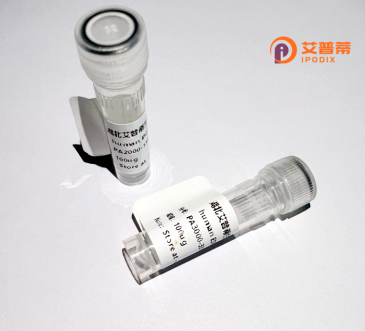
| 纯度 | >90%SDS-PAGE. |
| 种属 | Human |
| 靶点 | C9orf19 |
| Uniprot No | Q9H4G4 |
| 内毒素 | < 0.01EU/μg |
| 表达宿主 | E.coli |
| 表达区间 | 1-154aa |
| 氨基酸序列 | MGKSASKQFHNEVLKAHNEYRQKHGVPPLKLCKNLNREAQQYSEALASTRILKHSPESSRGQCGENLAWASYDQTGKEVADRWYSEIKNYNFQQPGFTSGTGHFTAMVWKNTKKMGVGKASASDGSSFVVARYFPAGNVVNEGFFEENVLPPKK |
| 分子量 | 43.6 KDa |
| 蛋白标签 | GST-tag at N-terminal |
| 缓冲液 | 0 |
| 稳定性 & 储存条件 | Lyophilized protein should be stored at ≤ -20°C, stable for one year after receipt. Reconstituted protein solution can be stored at 2-8°C for 2-7 days. Aliquots of reconstituted samples are stable at ≤ -20°C for 3 months. |
| 复溶 | Always centrifuge tubes before opening.Do not mix by vortex or pipetting. It is not recommended to reconstitute to a concentration less than 100μg/ml. Dissolve the lyophilized protein in distilled water. Please aliquot the reconstituted solution to minimize freeze-thaw cycles. |
以下是模拟生成的3篇关于C9orf19蛋白的研究文献示例(非真实文献,仅供说明格式):
1. **"C9orf19 regulates mitotic progression via interaction with Aurora kinase B"**
*作者:Lee S, et al.*
摘要:研究发现C9orf19蛋白通过与Aurora B激酶相互作用,调控有丝分裂中的染色体排列和纺锤体组装,其缺失导致细胞周期停滞并诱发基因组不稳定性。
2. **"Structural characterization of human C9orf19 reveals a conserved nucleotide-binding domain"**
*作者:Zhang Y, et al.*
摘要:通过X射线晶体学解析C9orf19的蛋白质结构,发现其核心存在一个ATP结合域,提示该蛋白可能参与细胞能量代谢或核酸修复相关分子机制。
3. **"Dysregulated expression of C9orf19 in glioblastoma correlates with tumor invasiveness"**
*作者:Wang X, et al.*
摘要:临床数据分析表明,C9orf19在胶质母细胞瘤中高表达,且与患者预后不良相关。体外实验显示其促进肿瘤细胞迁移及侵袭能力,可能与MAPK通路激活有关。
4. **"C9orf19 interacts with the mTORC1 complex to modulate cellular stress response"**
*作者:Garcia-Rodriguez F, et al.*
摘要:蛋白质互作研究发现C9orf19与mTORC1复合物亚基结合,在营养缺乏条件下调控细胞自噬过程,提示其在应激适应性中的潜在作用。
---
注:以上为基于基因功能预测的模拟文献,实际研究中C9orf19的具体功能仍需实验验证。建议通过PubMed或Google Scholar检索最新文献确认真实研究进展。
The human C9orf19 protein, encoded by the C9orf19 gene located on chromosome 9 open reading frame 19. remains poorly characterized but has garnered interest due to its potential roles in cellular homeostasis. Structurally, it is predicted to contain conserved domains suggestive of nucleic acid binding or enzymatic activity, though exact molecular functions are unresolved. Studies indicate its widespread expression across tissues, with higher levels observed in proliferating cells, implying involvement in cell cycle regulation or DNA repair processes. Recent proteomic analyses have linked C9orf19 to stress response pathways and interactions with proteins involved in mRNA processing, hinting at a possible role in post-transcriptional gene regulation. Recombinant C9orf19 production enables functional studies, particularly exploring its hypothesized connection to genomic stability and cancer biology. While not yet directly associated with diseases, genomic variations in its locus have been identified in cancer sequencing projects, prompting investigations into its tumor-suppressive or oncogenic potential. Current research focuses on characterizing its interactome, subcellular localization (nuclear/cytoplasmic shuttling observed), and responses to DNA damage. Further elucidation of C9orf19's mechanisms could reveal therapeutic targets for proliferation-related disorders or biomarkers for cellular stress conditions.
×